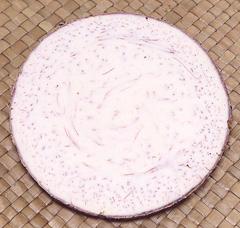Big Taro Corms
 [Big Taro (Philippine market); Badjang (Philippines); Unknown]
[Big Taro (Philippine market); Badjang (Philippines); Unknown]
Here We have a serious identification problem. All the Philippine and
Southeast Asian markets here in Los Angeles have these corms, often labeled
"Big Taro". Wikipedia and Creative Commons have totally failed me here.
My 5 fine Philippine cookbooks failed me even worse. Only one even admitted
that Taro Corms of any kind were edible, discussing only the leaves.
Philippine agricultural pages did no better.
The only Giant Alocasia I can find any information on anywhere is Alocasia
macrorrhizos, but no photos, YouTube videos, or descriptions show or
describe anything even remotely resembling the corm in the photo. Botanists
and gardeners, of course, have no interest in anything but leaves and flowers,
so barely mention corms. I have concluded that nobody actually knows much
about these.
Here I will discuss only the characteristics of the Corms sold here in Los
Angeles, whatever they may be, under the name "Big Taro", the only name I can
vouch for. The photo specimen was 10-1/4 inches long, 4-3/4 inches diameter
and weighed 4 pounds 6 ounces (2 kg). They get quite a bit larger, but this
was the largest one I could find that hadn't been cut to make its size
more manageable.
More on Arums.
 To the left is a slice of the Corm in the photo at the top of this page.
Cut into 3/4 to 1 inch cubes it cooked in just 10 minutes after coming to
a boil, and was crumbly in texture. The flavor was pleasant and surprisingly
sweet. The crumbling mitigates against using in soups and stews. It seems
probably it is always used as a mash. There was no hint of oxalic acid or
calcium oxalate, even in the peel.
To the left is a slice of the Corm in the photo at the top of this page.
Cut into 3/4 to 1 inch cubes it cooked in just 10 minutes after coming to
a boil, and was crumbly in texture. The flavor was pleasant and surprisingly
sweet. The crumbling mitigates against using in soups and stews. It seems
probably it is always used as a mash. There was no hint of oxalic acid or
calcium oxalate, even in the peel.
Buying:
"Big Taro" corms are widely available in Philippine
and Southeast Asian markets, at least here in Southern California. They
should be firm and unwrinkled, with no soft spots or mold. Check the small
end for any softness. They are not yet grown in Africa or the Tropical
Americas, so will not appear in markets serving those communities.
The photo specimen was purchased from a Philippine market in Los Angeles
(Eagle Rock) for 2022 US $0.99 / pound.
Storing:
The photo specimen, as purchased, was wrapped in
stretch film to prevent dehydration. Keep in a cool dry place with no
direct sunlight they will keep for maybe a week. Check for softening,
particularly at the small end, and use immediately if detected. The decay
will go deep very quickly.
Cooking:
Big Taro corms should be peeled, though I detected
no toxic Oxalic Acid and Oxalates. Cut into 3/4 to 1 inch cubes, and cooked
for just 10 minutes after coming to a boil, cubes from the outer edge still
had a some firmness at the edge, while interior cubes were already soft and
crumbling. With another couple of minutes cooking it would be ready to
make a mash.
Another person who was also only able to identify this corm as "Big Taro"
had not seen it before. He just popped the whole corm into the Microwave
and nuked it. He was quite happy with the result, which was fluffy like
mashed potatoes, but drier.
am_tarobgz.html 210118 www.clovegarden.com
© Andrew Grygus - agryg@clovegarden.com - Photos on
this page not otherwise credited are ©
cg1.- Linking to and non-commercial use
of this page permitted.
 To the left is a slice of the Corm in the photo at the top of this page.
Cut into 3/4 to 1 inch cubes it cooked in just 10 minutes after coming to
a boil, and was crumbly in texture. The flavor was pleasant and surprisingly
sweet. The crumbling mitigates against using in soups and stews. It seems
probably it is always used as a mash. There was no hint of oxalic acid or
calcium oxalate, even in the peel.
To the left is a slice of the Corm in the photo at the top of this page.
Cut into 3/4 to 1 inch cubes it cooked in just 10 minutes after coming to
a boil, and was crumbly in texture. The flavor was pleasant and surprisingly
sweet. The crumbling mitigates against using in soups and stews. It seems
probably it is always used as a mash. There was no hint of oxalic acid or
calcium oxalate, even in the peel. [Big Taro (Philippine market); Badjang (Philippines); Unknown]
[Big Taro (Philippine market); Badjang (Philippines); Unknown]